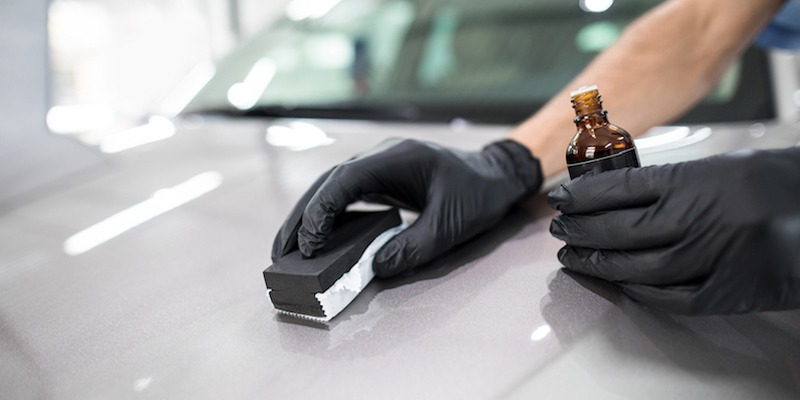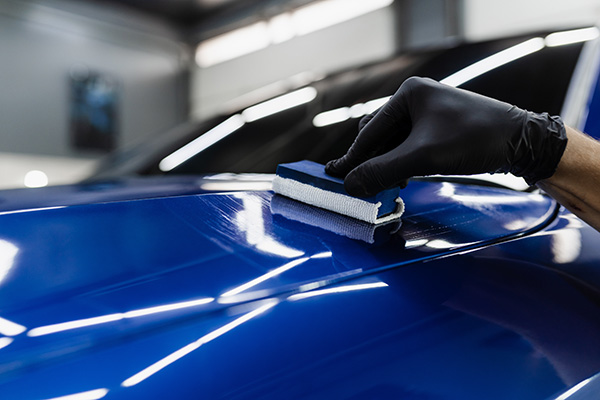The Environmental Benefits of Using Ceramic Coating on Your Vehicle
The Environmental Benefits of Using Ceramic Coating on Your Vehicle
Blog Article
Understanding the Science Behind Ceramic Coating for Boosted Vehicle Toughness
The scientific research of ceramic coating is reinventing car upkeep by offering a formidable guard against rough environmental variables. As we explore the complex structure and application procedure of ceramic finishings, we reveal the keys behind their premium protection and durability (ceramic coating). How does this compare to traditional methods, and what ramifications does it have for automobile maintenance in the long term?

Make-up of Ceramic Coatings
Ceramic finishings are mostly made up of silicon dioxide (SiO2), which is obtained from all-natural products like quartz and sand. This substance forms the backbone of the covering, offering its particular solidity and resistance to environmental elements. In enhancement to SiO2, ceramic coatings typically include titanium dioxide (TiO2) for enhanced UV protection and increased resistance to toxic wastes. These nanocomposite products develop a durable, chemical bond with the lorry's surface, offering a long-lasting protective layer.
The formulation of ceramic finishings is a careful procedure where the concentration of SiO2 can dramatically influence the covering's performance. Greater SiO2 content usually leads to higher resilience and firmness, adding to the layer's ability to stand up to scrapes and chemical etching. Nevertheless, the balance of parts is critical; way too much SiO2 can make the coating breakable, while inadequate can endanger its safety homes.
Producers may also integrate added substances, such as polysilazane, to improve adaptability and simplicity of application. These ingredients enhance the coating's hydrophobic properties, making certain water and pollutants bead off the surface area easily. This crafted structure underscores the effectiveness of ceramic finishings in safeguarding an automobile's exterior against a variety of negative conditions.
Application Refine Explained
Applying a ceramic finishing to a lorry includes a number of essential steps, each crucial to making certain optimal bond and performance of the protective layer - ceramic coating. The procedure starts with a thorough wash and decontamination of the vehicle's surface area to remove dirt, gunk, and previous waxes or sealants. This step is critical as any contaminants left on the surface area can prevent the coating's capacity to bond successfully
Following the preliminary cleansing, the following step includes polishing the vehicle to get rid of any kind of imperfections, such as swirl marks or scratches. Polishing guarantees a smooth surface, which is vital for the layer to stick correctly and supply an uniform coating. After brightening, a surface preparation spray is made use of to get rid of any type of continuing to be residues and make sure that the surface area is completely tidy.

Safety Benefits
Usually hailed for its remarkable protective high qualities, a ceramic finish uses numerous benefits that considerably improve car durability. At its core, ceramic finish creates a hard, semi-permanent barrier over a car's outside, which acts as a guard versus different environmental threats.
Moreover, ceramic coatings show hydrophobic buildings, suggesting they ward off water and help with a self-cleaning impact. This characteristic minimizes the adherence of dirt and mud, you could check here simplifying maintenance and cleansing processes. The finish's resistance to chemical etching additionally makes sure that the lorry's surface area remains unblemished in spite of direct exposure to rough cleaner and contaminants.
In enhancement to these protective benefits, the ceramic covering boosts a car's aesthetic allure by developing a glossy coating that emphasizes color depth and clarity. This not just maintains the car's visual allure yet additionally adds to its long-term value by maintaining the stability of its outside over time.
Contrasting to Standard Methods
Unlike typical techniques of lorry defense, such as shaving or sealants, ceramic coatings provide a more long lasting and long-lasting option. Where waxes and sealers normally supply a short-term layer of protection, frequently requiring reapplication every few months, ceramic layers develop a semi-permanent bond with the lorry's paint. This bond develops a safety layer that is immune to ecological impurities, UV damage, and small abrasions.
Traditional waxes are mostly made up of all-natural elements like carnauba wax, giving a glossy surface but lacking the durable protective qualities of ceramic finishings. Sealers, while synthetic and offering somewhat better durability than waxes, still fall short in comparison to the resilience and chemical resistance of ceramic finishings. The innovative technology of ceramic coverings integrates nanotechnology, which permits them to complete tiny imperfections in the paint surface area, resulting in a smoother and a lot more hydrophobic surface.
In regards to application, ceramic coatings call for a more precise procedure, often demanding professional installment to guarantee optimum performance. This contrasts with the relatively uncomplicated application of waxes and sealers, which can be used in your home. The remarkable defense and visual enhancement provided by ceramic coatings justify the investment for those seeking long-term vehicle preservation.
Long Life and Upkeep
How does the durability of ceramic layers translate into convenience of upkeep for car proprietors? The innovative formulation of ceramic finishes provides a robust protective layer on the car's surface, which significantly expands the lifespan of the car's exterior surface.
Furthermore, the hydrophobic nature of ceramic layers makes it possible for a knockout post water and various other liquids to grain up and roll off the surface, lugging dirt and particles with them. This home lessens the buildup of contaminants, making routine cleaning a lot more efficient and much less labor-intensive. Owners take advantage of a consistently streamlined, glossy appearance with minimal effort. However, while the covering itself is resilient, it is not completely maintenance-free. Routine examinations for damages and occasional reapplication are advised to make certain the protective layer remains intact. Thus, ceramic finishings supply an important equilibrium in between long-lasting durability and simplified maintenance for automobile treatment.
Final Thought
Ceramic finishings, with their advanced chemical structure of silicon dioxide and titanium dioxide, offer an awesome barrier against environmental damage, dramatically boosting automobile toughness. When contrasted to typical look at this site methods, ceramic layers supply premium security versus UV rays, oxidation, and chemical etching - ceramic coating.
The formulation of ceramic layers is a thorough process where the focus of SiO2 can significantly influence the coating's efficiency.Applying a ceramic finishing to a vehicle includes a number of crucial steps, each important to making certain optimum attachment and performance of the protective layer.Often hailed for its extraordinary protective qualities, a ceramic finishing provides numerous advantages that considerably boost lorry longevity. The innovative solution of ceramic finishes provides a robust safety layer on the automobile's surface, which considerably extends the life-span of the auto's exterior finish.Ceramic layers, with their innovative chemical make-up of silicon dioxide and titanium dioxide, give a formidable obstacle against environmental damage, considerably improving car durability.
Report this page